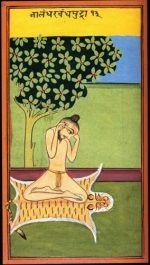The meaning and formation of the word "pranayama"
प्राणयाम prāṇayāma
प्र । pra । pra
अन । ana । ana
प्राण । prāṇa । praana
आ । ā । aa
याम । yāma । yaama
प्राणायाम । prāṇāyāma
Meanings of the term "prana"
from the Ayurveda dictionary
प्राण । prāṇa । praana
Breath of life—vital breath.
Spirit—spirit.
Life is life.
प्राण वायु - prāṇa vāyu - prana as life energy
Names of some diseases associated with prana according to Ayurveda
On the meaning of the word "pranayama":
It explains the meaning of this prefix in this way: "ā means boundary and a completed process". Thus, pranayama is not just sluggish control in the sense of "monitoring" the breath, but rather the activity of bringing the breath under control.
From a linguistic point of view, those are nuances, but from a practical point of view, the difference is huge. By the way, Kaundinya also gives a quite impressive list of pranayamas and prescribes asanas (padmasana, siddhasana) in which it is better to practice pranayamas. The text also indicates the purpose of this practice - "emotional alignment".
Pranayama in primary sources of yoga
Yoga Sutra
Yoga texts pay a lot of attention to pranayamas and breath control. The reason is that pranayama is an exercise that prepares for meditation. The lines of the second chapter of the Yoga Sutra are exactly about this:
tataḥ kṣīyate prakāśāvaraṇam ॥ 52॥
dhāraṇāsu ca yogyatā manasaḥ ॥ 53॥
Yogakundalya Upanishad
Yoga-Yajnavalkya
Yoga-Yajnavalkya prescribes practices that should be done before pranayamas. These are necessary preliminary exercises:
sarve ca abhyantarāḥ rogāḥ vinaśyanti viṣāṇi ca ।
yamaiḥ ca niyamaiḥ ca eva āsanaiḥ ca susaṃyutā ॥ 17॥
nāḍīśuddhiṃ ca kṛtvā tu prāṇāyāmaṃ tataḥ kuru ॥
Hatha Yoga Pradipika
Hatha Yoga Pradipika prescribes to master pranayama gradually:
yathā siṃho gajo vyāghro bhavedvaśyaḥ śanaiḥ śanaiḥ ।
tathaiva sevito vāyuranyathāhanti sādhakam ॥ 6॥
Pranayama in modern yoga books
About the tasks of pranayama
About the age of asanas and pranayamas
"Bandhas and mudras (such as Mahamudra and Mahavedha) appeared next and are described in the oldest Hatha Yoga text that has come down to us, Amritasiddhi (about the 11th century; by the way, it is bilingual - written in Sanskrit and Tibetan)."
Yoga sequences with pranayamas
A series of gross pranayamas for advanced practitioners
Prenatal Yoga
Yoga therapists' articles about pranayamas
Yoga—the Way to the Good Heart
One of Pranayama Curative Mechanisms. In this article, one will find a detailed description of the influence of pranayama upon the heart.
Ujjayi (snake breathing) in Yoga therapy of Obstructive Sleep Apnea Syndrome
How shall I breathe if I snore?
Bhastrika, The Effects, and Mechanisms of Health Improvement
This article consists of three parts that cover:
⁃ Bhastrika and musculoskeletal system;
⁃ Bhastrika and apparatus of external respiration;
⁃ Practical recommendations.
Pranayama: a Pearl in Hatha Yoga Treasure-House
In this article, one can find out how pranayama affecting the body of the practitioner. The author of the article gives u an introduction to:
⁃ Anatomy of the respiratory system;
⁃ Physiology;
⁃ Yoga, or the way it all works.
Pranayama as Meditation
Different stages of the practitioner’s response to pranayama are described:
⁃ the stage of breathing stereotypes formation and initial performance of the pranayama;
⁃ the stage of psychosomatic posture actualization;
⁃ the stage of rearrangement;
⁃ the stage of new stereotype imprinting.
Some of Ujjayi Effects, or Relaxation that Comes after Victory
Ujjayi breathing is a breathwork done in vibratory key (successive singing of sounds that compose the OM mantra) that in our School tradition is practiced almost from the very beginning.
Cleansing Breath in Yoga - Mechanisms, Effects, Indications
The Influence of Cleansing Breath upon the cardiovascular, respiratory, muscular, and nervous system is presented in the article.
Pranayama Dictionary
words from which the names of pranayamas are formed
• lock • bandha • बंध •
• holding • dhara • धर • mula-dhara-bandha (lock in the place of holding the root)
• water • jalam • जालम् • jalan-dhara-bandha (throat lock)
• taking off • uddiyana • उड्डीयान • uddiyana-bandha (diaphragmatic lock)
• action • kriya • क्रिया • uddiyana-bandha-kriya
• inhale • puraka • पूरक •
• pot • kumbhaka • कुंभक •
• exhale • rechaka • रेचक •
• skull • kapala • कपल • kapala-bhati
• light • bhati • भाति • kapala-bhati
• in wool (in natural order) • anuloma • अनुलोम • anuloma-viloma
• against wool (in an unnatural order) • fork • विलोम
• bellows (kindling) • bhastrika • भास्त्रिक
• sun (right channel and right nostril) • surya • सूर्य • surya-bheda (right nostril breathing)
• moon (left channel and left nostril) • chandra चन्द्र • chandra-bheda (left nostril breathing)
• division, separation • bheda • भोद
• bee • bhramari • भ्रमरी

